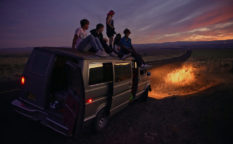Review: Movements of a Nearby Mountain (2019), by Sebastian Brameshuber
Austrian filmmaker Sebastian Brameshuber has made a name for himself directing observational documentaries and shorts in a specific manner that makes his films more real than reality, and stranger than fiction at the same time. His third, Movements of a Nearby Mountain, premiered at this year’s edition of Cinéma du réel, where it pocketed the Grand Prix, before its national opening at the Diagonale in Graz – where it was awarded for the Best Cinematography. Other festivals and special screenings are already scheduled.
The mountain the title refers to is Erzberg in the Styrian parts of Austrian Alps, already mentioned in Roman times and legendary for its rich iron ore deposits. However, our hero, a 30-something Nigerian immigrant Cliff, is not a miner or a steel forger, but is at the opposite end of the production process, dealing with rust. He is a mechanic specialized in buying beat-up cars, revitalizing some of them while taking apart the others, selling some of the usable parts to his regular buyers, exporting the others to his home country and scrapping the rest. He is a bit of a wheeler-dealer, but he is not shady at all: he is honest, friendly and helpful, but firm when it comes to sticking to his prices.
Also, for the most of the time, he is completely alone, surrounded by cars, parts and scraps. Sometimes he sings a tune to himself to have a sense of company. Sometimes he goes for a meditative cigarette break. He cooks his meals, dries his clothes, works and lives at the same secluded compound surrounded by woods, mountain streams and a road. His pace is pretty much always the same, so we do not get a sense that he is ever resting or in a hurry. The only company he gets are his clients and, occasionally, his colleague Magnus who has a simple dream to earn enough money to buy a fleet of used cars and start a taxi business in Nigeria. For instance, the first human interaction Cliff has is 10 minutes in, and it is of a business nature, so it is safe to assume that he has no social life at all.
One may ask how Cliff keeps his mind sane in complete isolation and that is actually the prime target of Brameshuber’s curiosity. That question will remain largely unanswered, since he is always an observer and never an interpreter. He keeps the distance to his subject, leaving him to interact freely with his surroundings, places, people, cars. We even see Cliff on his scouting rounds, but he never discusses the routines of his trade with the audience. We just see him working day in – day out, year in – year out, not noticing the difference nor being able to scope the time-frame. Brameshuber makes a point of sorts with that: Movements of a Nearby Mountain is not a typical social-issues type of documentary, but a profoundly humane one that under the surface of the story about a man and his work implies a whole lot of questions, including such considering race, class, geography, political economics or colonialism.
At the same time, Movements of a Nearby Mountain is a beautiful film to look at, thanks to Klemens Hufnagl’s attractive cinematography usually in wide shots and experiments with different formats and granulation. The editing handled by a Bosnian-Serbian slow cinema docu-fiction auteur Dane Komljen is also one of the film’s strong points and it suits the story perfectly. Who would say that scrapping cars by a mountain road would be as meditative as driving them on the same location
Country: Austria, France, Nigeria
Language: German
Runtime: 86 minutes
Written/ Directed by: Sebastian Brameshuber
Cinematography: Klemens Hufnagl
Editing: Dane Komljen
Producers: David Bohun, Ralph Weiser
Production Companies: Mischief Films, Panama Film, Le Fresnoy
















